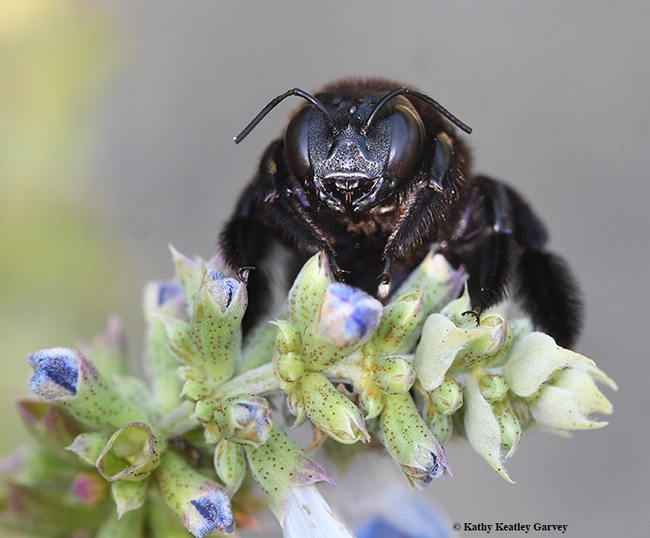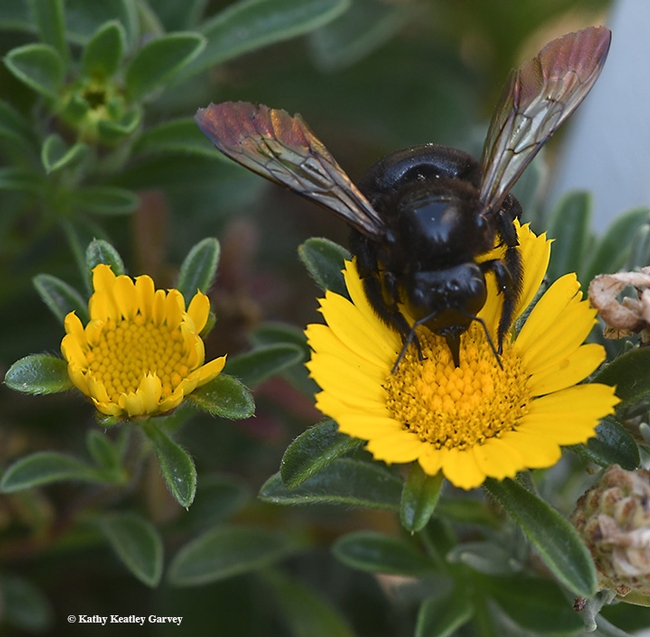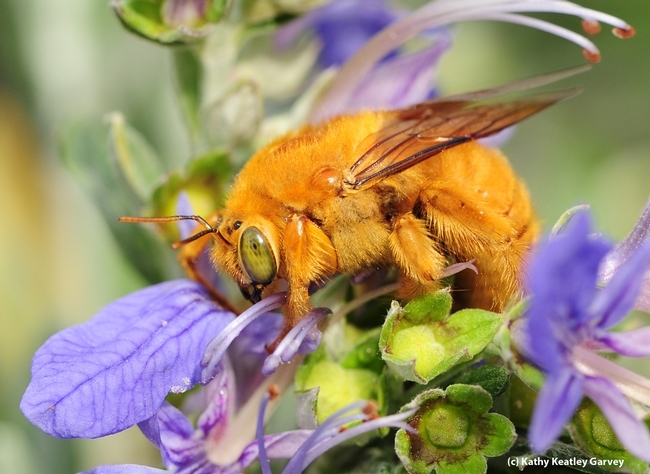- Author: Kathy Keatley Garvey
As National Pollinator Month winds down, let's visit a "morning" carpenter bee and an evening primrose.
The evening primrose, Oenothera biennis, native to the Americas, is unique in that it blooms as night (as its name implies) and dies back at noon.
Early in the morning on June 25, we spotted a female Valley carpenter bee, Xylocopa sonorina, heading over to an evening primrose. This four-petaled yellow flower, is lemon-scented. Simply spectacular!
Our carpenter bee, already dusted with yellow, made a bee-line for some more nectar and pollen. The yellow pollen resembled gold dust on a miner.
"Over the centuries, indigenous people in North America have used the plant as food and traditional medicine," according to Wikipedia. "The seeds of the plant are important food for birds, including American goldfinch, Northern bobwhite, and mourning dove, and it is a larval host for both the primrose moth and the white-lined sphinx moth. Bumblebees and honeybees also visit the flowers."
So do carpenter bees! (And syrphid flies and more!)
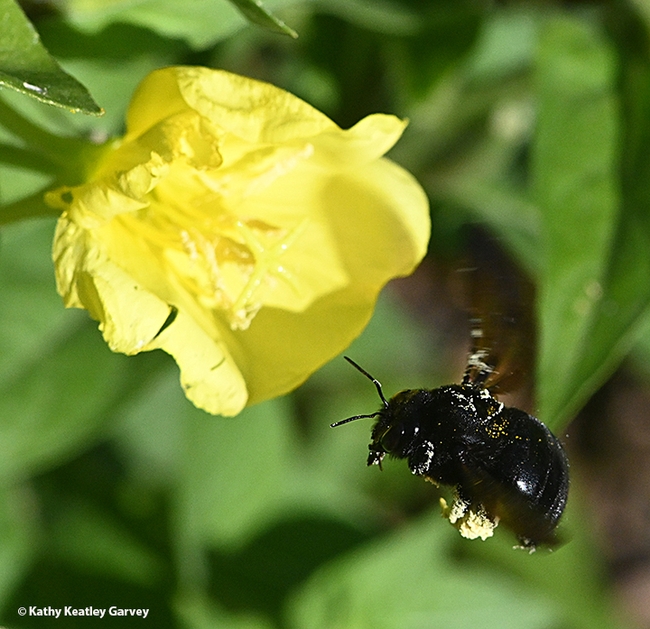
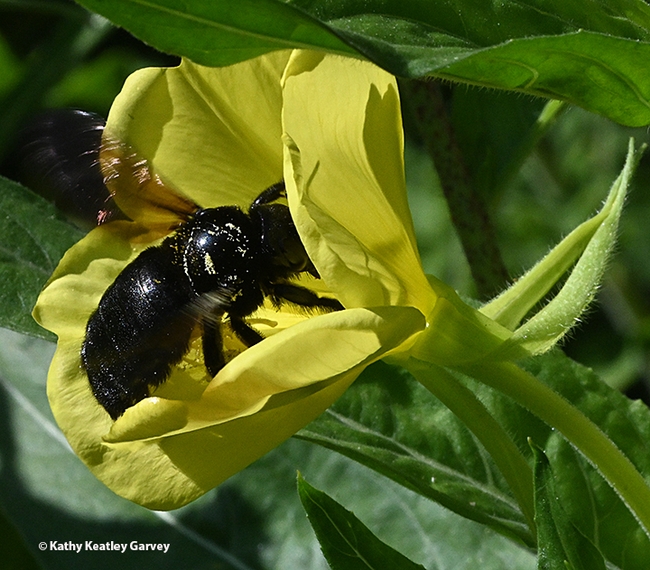
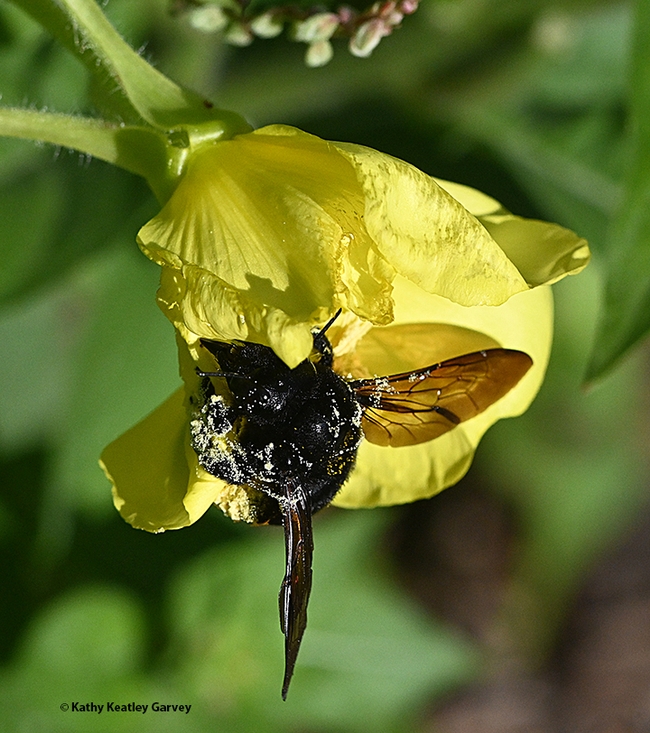
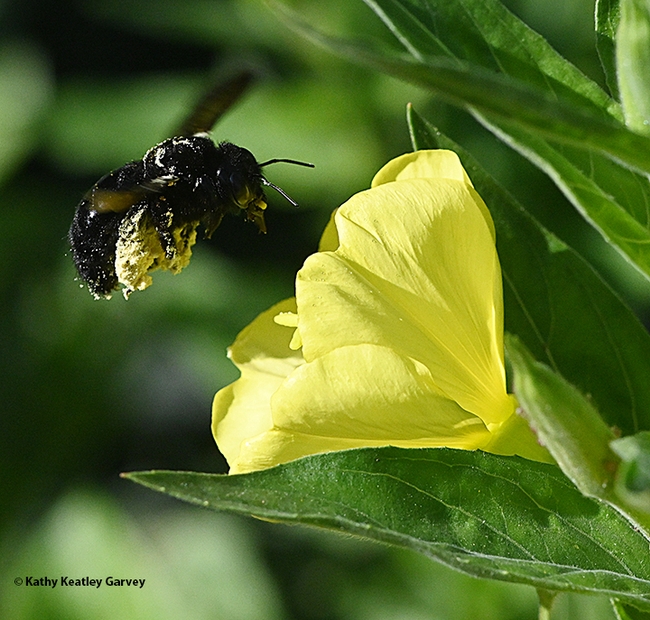
- Author: Kathy Keatley Garvey
It's always a good idea to carry your cell phone or shoulder a camera while you're taking a stroll through a garden.
You never know what you will see.
It was early morning on Tuesday, June 7, when we spotted a female Valley carpenter bee, Xylocopa sonorina, asleep on a passionflower vine, Passiflora. That's the host plant for the Gulf Fritillary, Agraulis vanillae, but carpenter bees are always hanging around for pollination. Tiny grains of golden pollen cling to this bee look like gold dust.
The females are solid black, while the males are a golden blond with green eyes. Sexual dimorphism. These bees are found in the Central Valley and southern California, Arizona, New Mexico and southward through Mexico, according to the late native pollinator specialist Robbin Thorp, UC Davis emeritus professor of entomology. He described them as "the largest of the carpenter bees in California."
Wikipedia indicates Valley carpenter bees are found from western Texas to northern California, and the eastern Pacific islands. Frederick Smith, assistant in the Zoological Department of the British Museum and member of the council of the Entomological Society of London, first described X. sonorina in 1874 from specimens collected in Hawaii, according to Wikipedia. "Until 1956, it was thought that X. sonorina came from the Sunda Islands, but in a paper published that year,M. A. Lieftinck showed that Smith's interpretation of the original specimen labels was in error: Smith had mistakenly read the label of X. sonorina as meaning the Sunda Islands instead of the Sandwich Islands."
"In 1899, R. C. L. Perkins described the same species as Xylocopa aeneipennis, and in 1922, P. H. Timberlake claimed that the Hawaiian Xylocopa was the same as the mainland X. varipuncta, that had been named in 1879, and Roy Snelling predicted in 2003 that X. varipuncta would eventually be reclassified as a synonym of X. sonorina," Wikipedia relates. "This was confirmed in 2020 using DNA analysis, and as the name sonorina has seniority, this is the valid species name."
Up until 2020, we'd always called them X. varipuncta.
This week we called one "sleepy head."
Ms. Valley Carpenter Bee finally stirred and soon after, took flight.
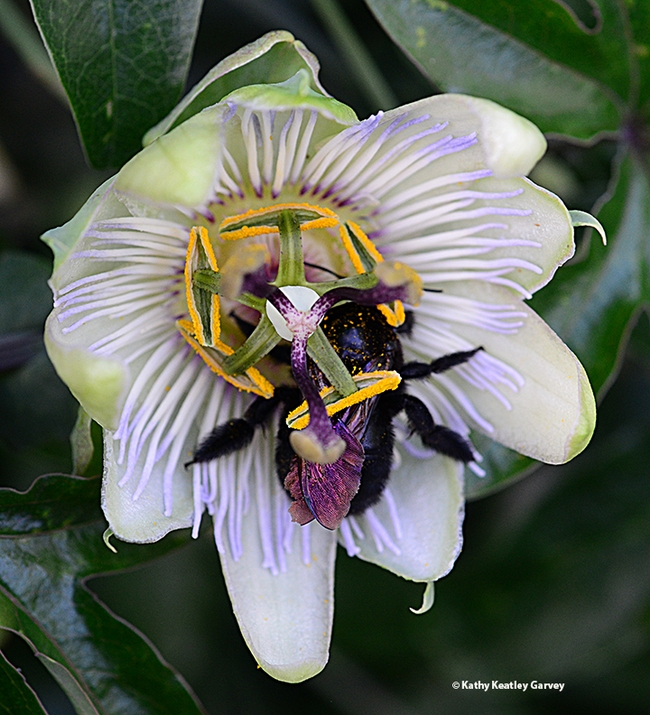
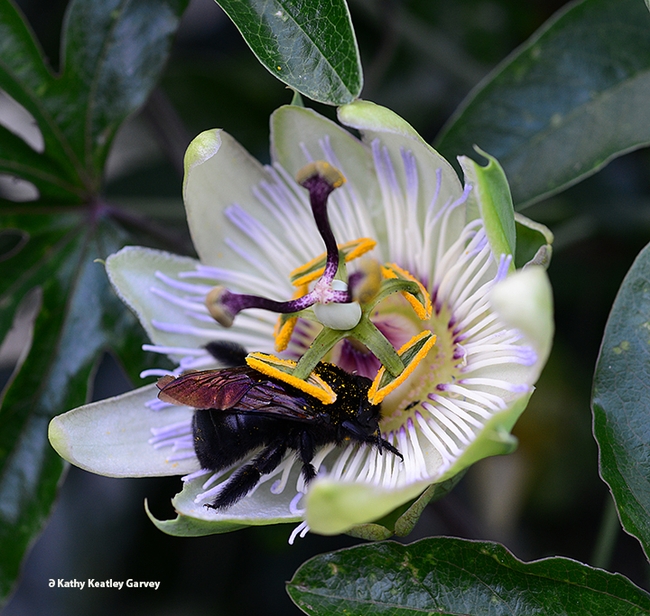
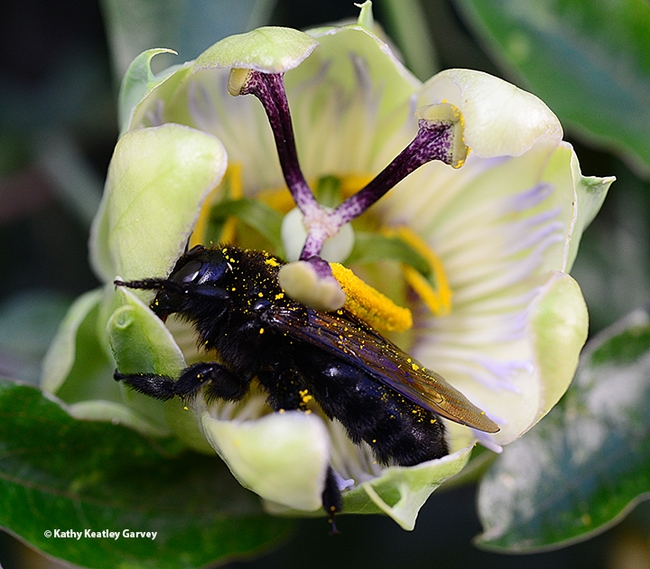
- Author: Kathy Keatley Garvey
There's a way for a bear to outsmart a fox.
A teddy bear bee, that is.
We just witnessed a male Valley carpenter bee, Xylocopa sonorina, aka "the teddy bear bee," buzz up to a patch of foxgloves, Digitalis purpurea.
Then he engaged in the foraging behavior known as nectar-robbing. That's when a carpenter bee or bumble bee drills a hole at the base of the corolla--or finds a hole already drilled--and "robs" the nectar, bypassing the flower's reproductive parts that lead to pollination.
Hey, I'm not going through the front door! I'm not! I'm taking the back door.
We usually see female Valley carpenter bees drilling the holes and robbing the nectar. This time, though, it was a male. The late Robbin Thorp, UC Davis distinguished emeritus professor of entomology, always referred to the males as "teddy bear bees," adding "boy bees don't sting."
This particular teddy bear lingered a bit, sipped some nectar, and then took flight.
That's how a "bear" outsmarts a fox.
By the way, sexual dimorphism is pronounced in X. sonorina. The male is a green-eyed blond, while the females are solid black.
In our garden, other plants popular for nectar robbing include the salvias, ‘Hot Lips' Sage (Salvia ‘Hot Lips'), and California fuchsia (Epilobium canum). Sometimes you'll see a honey bee following a carpenter bee or bumble bee around to gain easy access to the nectar. She "knows the drill."
Scientists have known about nectar-robbing for more than two centuries. German naturalist Christian Konrad Sprengel observed bumble bees perforating the corollas of flowers as early as 1793, according to Wikipedia. Sprengel recorded this phenomenon in his book, The Secret of Nature in the Form and Fertilization of Flowers Discovered. Charles Darwin observed nectar robbing (by bumble bees) in 1859 and published his observations in his book The Origin of Species.
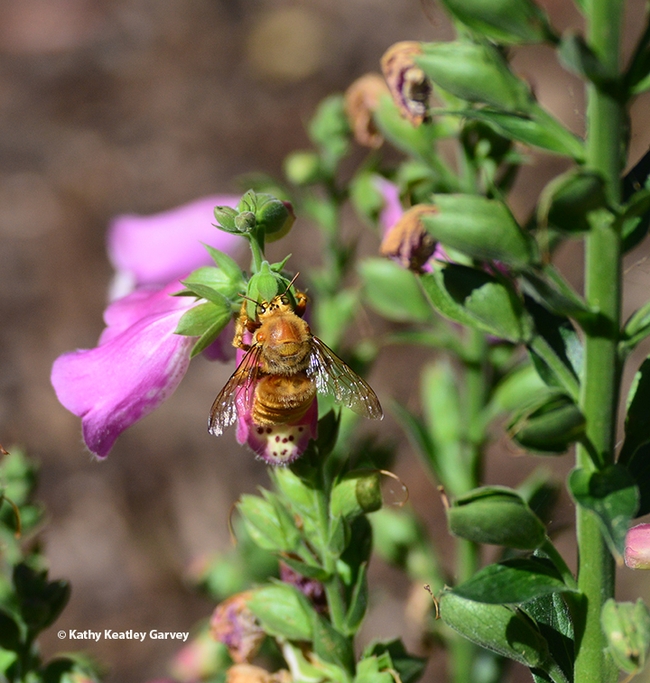
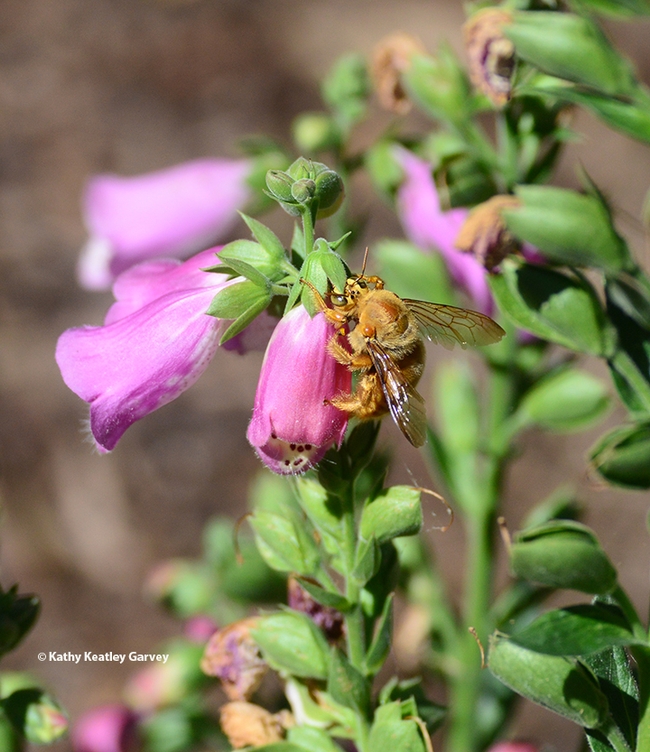
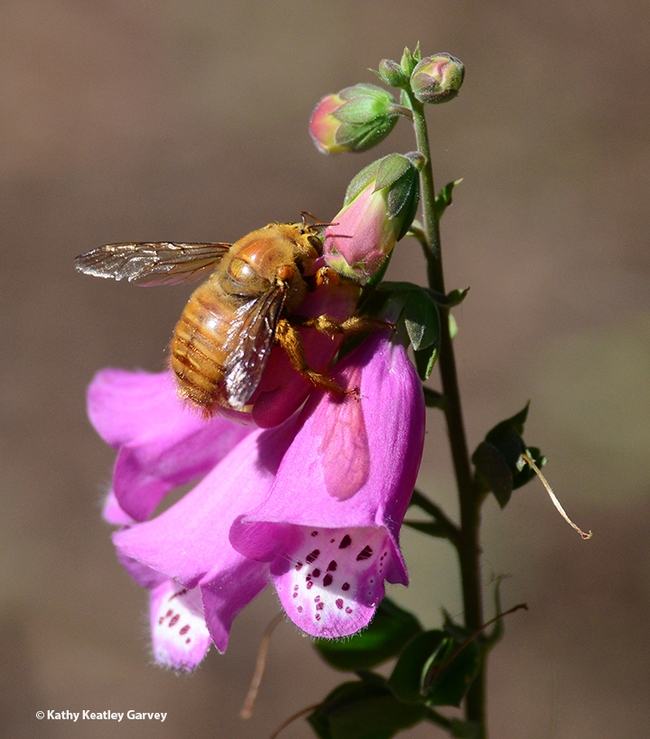
- Author: Kathy Keatley Garvey
Remember the biblical story about David and Goliath? How young David, the underdog, defeats a Philistine giant?
Sometimes you think the same kind of battle will occur in nature when a honey bee, Apis mellifera, encounters a much larger carpenter bee, the Valley carpenter bee, Xylocopa varipuncta.
We recently spotted a female Valley carpenter bee foraging on a mustard blossom, while her smaller cousin, the honey bee buzzed in, hoping to share. Both belong to the order Hymenoptera and the family, Apidae. The carpenter bee is a native. The honey bee is not.
Girls! Girls!
What happened? The honey bee discreetly moved out of the way and let the carpenter bee claim her bounty.
California has three species of carpenter bees.
- The biggest is the Valley carpenter bee, Xylocopa varipuncta. It's about an inch long. The female is solid black, while the male, commonly known as "the teddy bear bee," is a green-eyed blond. Why teddy bear? It's fuzzy and does not sting--or as the late Robbin Thorp (1933-2019), UC Davis emeritus professor of entomology, used to say: "Boy bees don't sting."
- The second largest is the California carpenter bee or Western carpenter bee, Xylocopa californica, often found in the mountain foothill areas of northern and southern California. It's known for its distinctive distinctive bluish metallic reflections on the body, Thorp says. The females have dark smoky brown wings.
- The smallest is the foothill or mountain carpenter bee, Xylocopa tabaniformis orpifex. The females are black with light smoky-colored wings. The male has bright yellow marks on the lower part of its face and some yellow hairs on the top front of its thorax.
Still my favorite carpenter bee is the male X. varipuncta, the green-eyed blond. You don't see it as much as the female of the species, but wow! Now to photograph them in the same picture...
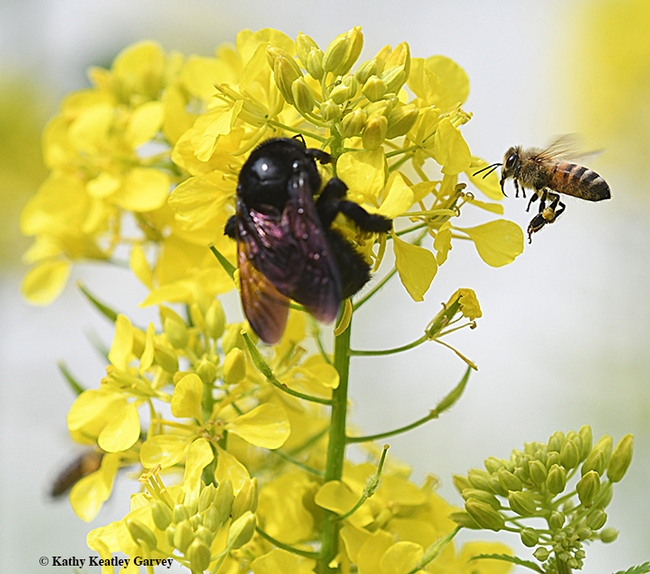
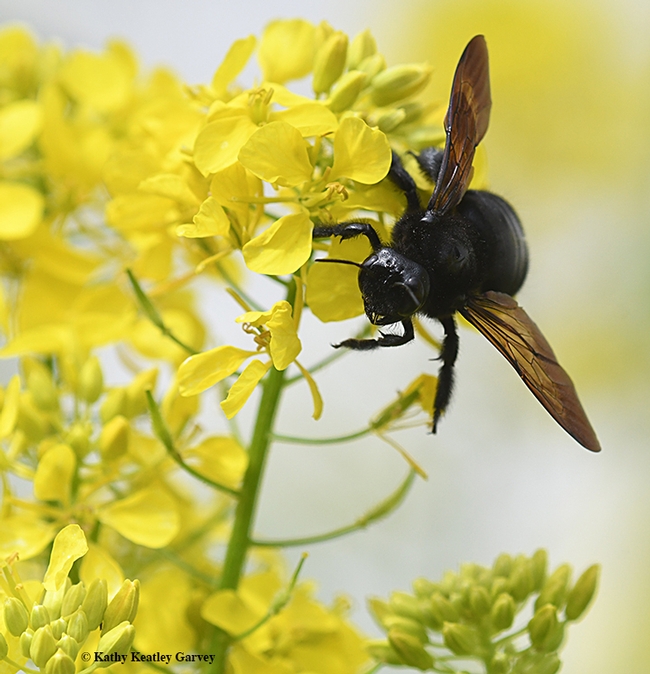
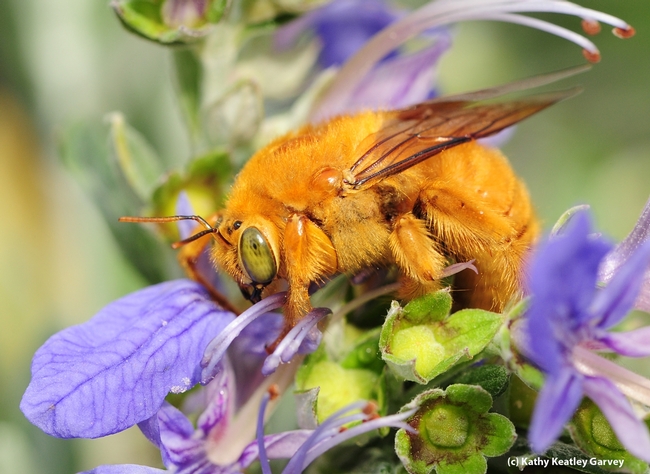
- Author: Kathy Keatley Garvey
Some folks call them "bumble bees," but they're not.
In size, the female Valley carpenter bee (Xylocopa varipuncta) resembles a bumble bee, but certainly not in color.
The female Valley carpenter is solid black with metallic wings. The male of the species is a green-eyed blond, fondly known as "the teddy bear" bee because it's fuzzy-wuzzy and cannot sting. Entomologists will tell you that the male and female are dramatic examples of sexual dimorphism. Yes, they are!
We've been seeing a lot of female Valley carpenter bees lately on our blue spike salvia, (Salvia uliginosa). They engage in nectar-robbing: this occurs when bees circumvent the usual plant-pollinator relationship and "cheat" by entering a flower from the outside to steal nectar. They drill a hole in the corolla to reach the nectar, thus avoiding pollination or contact with the anthers.
Similar-looking insects include bumble bees, cactus flies and horse flies, according to California Bees and Blooms, a Guide for Gardeners and Naturalists,by UC-affiliated authors Gordon Frankie, Robbin Thorp, Rollin Coville, and Barbara Ertter. "Carpenter bees are shinier and have less hair than fuzzy bumble bees. Carpenter bees have two pairs of wings, and they have long, slender, elbowed antennae, while fly mimics have only one pair of wings, and short stubby antennae."
The Valley carpenter bee is California's largest carpenter bee.
They're large but they're elusive. They usually don't linger long for you to grab a photo. This one did. It was early in the morning, and like a true human morning person, she declined to move fast.
